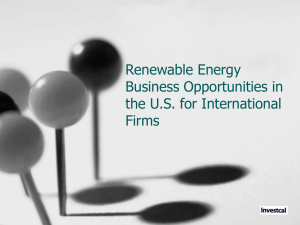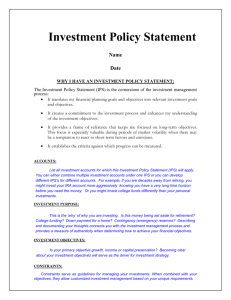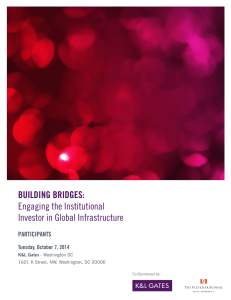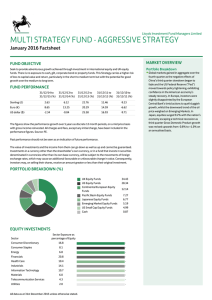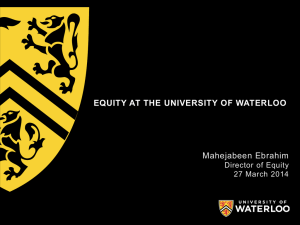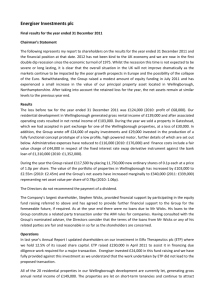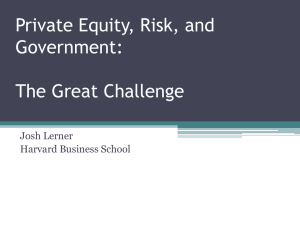CLICK TO ADD TITLE
advertisement
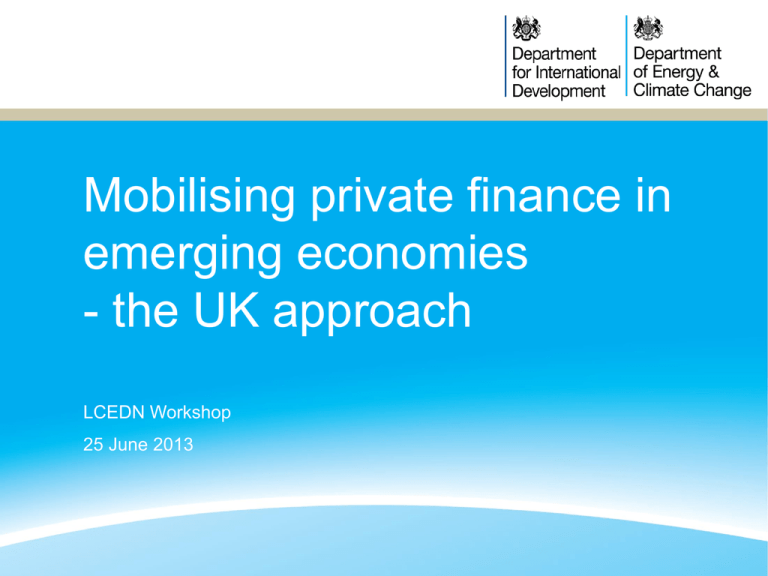
Mobilising private finance in emerging economies - the UK approach LCEDN Workshop 25 June 2013 UK’s International Climate Fund • £2.9 billion 2011- 2015 • Split between adaptation (c.50%), low carbon development (c.30%) and forests (c.20%) • Delivering transformational change • Priorities: – Demonstrate that building low carbon, climate resilient growth at scale is feasible and desirable – Support the international climate negotiations, particularly through supporting adaptation in poor countries and building an effective international architecture – Drive innovation and new ideas for action, and create new partnerships with the private sector to support low carbon climate resilient growth – Results and measurement – MW, private finance £, CO2, jobs etc Importance of evaluations UK approach to mobilising private finance Reduce cost and raise returns Reduce actual and perceived risk Develop enabling environments, build capacity Considerations in designing programmes: • Additionality • Target market failure • Careful use of subsidy • Sustainability & exit • Risk appetite • Priority countries UK approach to mobilising private finance Private sector is not homogenous Pension funds behave quite differently to angel investors or project finance debt in infrastructure UK Government must be more hands off further along the development cycle or where institutional finance. Can be more involved with start up finance. Maximise expertise so focus on energy, not agriculture Consultation with business via CMCI and DFID focus groups Spread of programmes UK project – Climate Public Private Partnership “CP3” Two new commercially run private equity funds that will make investments in to climate friendly sub-funds and projects in developing countries. UK “hands off” approach. Aims • Drive new types of private money into climate investments e.g. pension funds, SWFs • Speed up the development of private equity market in climate change/climate friendly projects • Show climate investments are profitable by building network of sub-funds with good investment track records UK project – CP3 UK investment of £110 million + circa £11m technical assistance IFC Catalyst Fund CP3 Asia IFC AMC as fund managers CFIG + Asian Development Bank as fund managers Global focus Asia only 70% sub funds (with a focus on first time fund managers) 70-80% direct investments 20% sub funds First close: USD $281.5 million (UK $80, IFC $75 , Azerbaijan $50, Canada $76.5) Second close later Larger fund Get Fit Uganda Multi-donor project (UK contribution of £20 million plus), providing top up grant to renewables Feed in Tariff, support to regulator, use of World Bank Guarantees 1MW to 20MW plants– bagasse, hydro, biogas etc Aims • Demonstrate to private sector developers that investment in renewable energy in countries like Uganda is financially attractive • Demonstrate to Ugandan and regional governments that incentivising investment in renewable energy can mobilise private sector investment. UK project – Green Africa Power New Private Infrastructure Development Group (PIDG) facility Aim: to demonstrate the commercial and technical feasibility of larger renewable energy projects in Africa 5 – 200MW projects All renewable technologies 75% to the poorer countries in Africa Uses patient (up to 15 year) capital, subordinated to other lenders but above equity (Debt equity hybrid) UK - minigrids (in development) Off grid infrastructure. Mini grids in Tanzania and Kenya Financing support – guarantees, loans etc for developers Technical support for development of regulations e.g. tariffs. Supporting innovation Prizes versus Challenge Funds Prizes – specific problem Will be launching later in year/early 2014. Tender out now for consultancy. Challenge Funds – themes with merit based award Examples – REACT, EEP, IDEAS Climate Innovation Centres . Hubs in Kenya, Vietnam, Ethiopia Getting innovations to market and to scale Results Based Financing Off grid market. Projects which are close to financial viability. Uses demand led concepts from vaccines – agree to pay top up subsidy for results. Flexible Fund – in progress Recognises “valley of death” after the challenge fund/initial grant before the VCs will come in. Working capital loans, grants, equity – i.e. “flexible” Forestry fund (in preparation) Working with supply chains Top ups for non viable activities and shifting from greenfield to brownfield Equity investments to propel sustainability Demonstration effect Suggestions for future focus Policy risk – UK work Readiness activity - to develop the policy and regulatory environments in developing countries e.g. Climatescope, India smart grids etc Local finance Cities Adaptation More information? UK Government Web site Enter “International Climate Fund” Also “Funding and partnerships with businesses in the UK and developing countries” Sign up for DFID Low carbon newsletter (includes information about other donor projects) and to join contacts list Email – a-bobin@dfid.gov.uk or gwarrander@dfid.gov.uk

